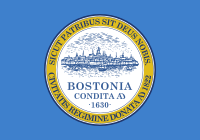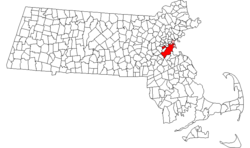Boston Police Department
| Boston Police Department | |
|---|---|
| Abbreviation | BPD |

Patch of the Boston Police Department
|
|

Badge of the Boston Police Department
|
|

Flag of the City of Boston
|
|
| Agency overview | |
| Formed | 1838 (predecessor) |
| Annual budget | $279 million (2013) |
| Legal personality | Governmental: Government agency |
| Jurisdictional structure | |
| Operations jurisdiction* | Commonwealth of Massachusetts, U.S. |
 |
|
| Map of Boston Police Department's jurisdiction. | |
| Size | 89.6 sq. miles |
| Population | 617,594 (2010 census) |
| Legal jurisdiction | Boston, Massachusetts |
| General nature | |
| Operational structure | |
| Headquarters | Boston, Massachusetts |
| Police Officers | 2,144 |
| Civilians | 569 |
| Police commissioner responsible | William B. Evans |
| Agency executive | William Gross, Superintendent In Chief |
| Facilities | |
| Patrol Vehicles | Ford Expedition, Ford F250 |
| Patrol cars | Ford Crown Victoria Police Interceptor, Ford Explorer, Chevrolet Caprice PPV |
| K-9s | 21 |
| Website | |
| Boston Police Website | |
| Footnotes | |
| * Divisional agency: Division of the country, over which the agency has usual operational jurisdiction. | |
The Boston Police Department (BPD), dating back to 1838, holds the primary responsibility for law enforcement and investigation within the city of Boston, Massachusetts. It is the first in the nation. The BPD is also the 20th largest law enforcement agency in the country and the 3rd largest in New England behind the Massachusetts State Police (2,300 officers) and the Massachusetts Department of Correction (4,000 officers).
Before the existence of a formal police department, the first night watch was established in Boston in 1635. In 1703, pay in the sum of 35 shillings a month was set for members of the night watch. In 1796, the watch was reorganized, and the watchmen carried a badge of office, a rattle, and a six-foot pole, which was painted blue and white with a hook on one end and a bill on the other. The hook was used to grab fleeing criminals, and the rounded "bill" was used as a weapon. The rattle was a noise-making device used for calling for assistance.
The Day Police, which had no connection to the night watch, was organized in 1838. The Day Police operated under the city marshal and had six appointed officers. This organization would eventually lead to the establishment of the modern-day Boston Police Department.
In 1838, a bill passed in the General Court that allowed the city to appoint police officers, paving the way for the creation of a formal police department. The Boston Police Department was formally founded in May 1854, at which point both the night watch and Day Police were disbanded. A fourteen-inch club replaced the old hook and bill, which had been in use for one hundred and fifty-four years. At the time of its founding, the Boston Police constituted one of the first paid, professional police services in the United States. The department was closely organized and modeled after Sir Robert Peel's (London) Metropolitan Police Service.
On November 3, 1851, the first Irish born Boston Police officer, Bernard "Barney" McGinniskin, was appointed. His presence generated considerable controversy. The Boston Pilot wrote, "He is the first Irishman that ever carried the stick of a policeman anywhere in this country, and meetings, even Faneuil Hall meetings, have been held to protect against the appointment." At the time, the police salary of $2.00 a day for the morning and afternoon beat and $1.20 for the night watch was nearly twice as high as the wages of laborers. City Marshal Francis Tukey resisted mayor John Prescott Bigelow's appointment of McGinniskin, expressing the predominant anti-Irish sentiments in the city by arguing it was done at "the expense of an American." On January 5, 1852, shortly before the newly elected mayor Benjamin Seaver (who had been supported by Tukey) took office, Tukey fired McGinniskin without giving a reason. After criticism in the press, Seaver reinstated McGinniskin, who remained in the police until the 1854 anti-Irish groundswell of the Know Nothing/American Party movement, when in the words of the Boston Pilot, "Mr. McGinniskin was discharged from the Boston Police for no other reason than he was a Catholic and born in Ireland." McGinniskin became a United States inspector at the customhouse and died of rheumatism on March 2, 1868. McGinniskin is buried in the St. Augustine Cemetery in South Boston.
...
Wikipedia
